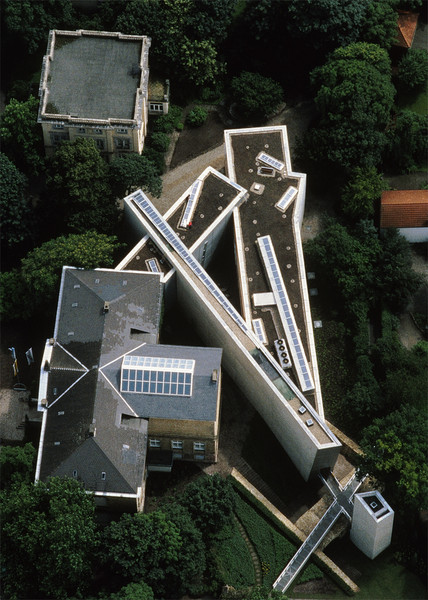
Felix Nussbaum Museum ,Osnabrueck, Germany
The Felix Nussbaum Museum is an extension to the Cultural History Museum in Osnabrück and is dedicated to the work of Felix Nussbaum, the Jewish artist born in Osnabrück in 1904. The Museum displays Nussbaum’s graphics and paintings done prior to his extermination in Auschwitz, and houses a temporary exhibition space focusing on the themes of racism and intolerance. The building was completed in the summer of 1998, in collaboration with Reinders & Partner Lange, and has already attracted more than 4 million visitors.
The Felix Nussbaum Museum是奥斯纳布吕克文化历史博物馆的扩充部分,同时也是为了纪念1904年生于Osnabrück的犹太人画家Felix Nussbaum。
博物馆展示了Felix Nussbaum在奥斯维辛集中营遇害前所创作的油画等作品,这个博物馆还有个关注于种族主义等主题的临时展示空间。
这一建筑于1998年夏完工,到目前为止已经吸引超过400万名游客。
The building consists of three main components: the tall and narrow central Nussbaum corridor, the long main section, and the bridge, which acts as a connection to the old museum. In its pathways with their sudden breaks, unpredictable intersections and dead ends, the building structure reflects the life of Felix Nussbaum.
"It is only by a fortuitous accident and the determined will of the town of Osnabrück that the name and works of Felix Nussbaum have been raised to consciousness amongst the millions of erased Jewish names and lost works. The task of building a Museum to house the artistic remnants of Nussbaum’s life raises issues which are not merely architectural but moral as well. I believe therefore, that the destruction of Jewish culture perpetuated by the Third Reich must not be dealt with solely in memorial terms. The remaining witnesses to the annihilation of European Jewry are now dying out. The paintings of Nussbaum are more than paintings - they are everliving documents which, placed in a new context of participation and a new witnessing, elevate the narration of history as art into the emblem of the very survival of the Jewish people and of European civilization. Every element of the spatial organization, geometry and programmatic content of this scheme refers to the paradigmatic destiny of Nussbaum: his prize in Rome removed by the Nazis, his time in Berlin, the consequences of his permanent exile from Osnabrück, the futility of his escape routes through France and Belgium, to his final deportation and murder in Auschwitz. And yet all this tragic destiny is placed in the context of Nussbaum’s abiding hope in ultimate justice which this proposed scheme seeks to fulfill.
"It is part of the mission of this design to house the Nussbaum collection in a new museum complex, as well as to transform the entire historical ensemble of buildings into yet another whole. Expressive of permanent absence, 'The Museum of the Unwitnessed and Unfulfilled' is a Museum resonant of both the fatality as well as the significance of the unrepresentable abyss of the Holocaust. The Museum has a particular task: to avoid a sentimental moment in order to thematize the existing historical context of Osnabrück through the disclosure of new cultural values.
"The different components of the new complex are seen as connecting and composing an integral structure, while at the same time exposing a permanent horizon of disconnection paradoxically linking significant places to the town; substantial points of history to spatial memory. The new building, therefore, does not seek to dominate as a new form, but rather retreats to form a background of hope for the existing Historical Museum and the Villa containing the folk art collection. These buildings are treated as the familiar, yet solitary every-day figures, while the entire site is reorganized around the nexus of a new topography which connects the town back onto itself. The Nussbaum Museum becomes the link to a lost history. It acts as a transformer, transmitting the mysterious irreversibility of time and destiny.




 cityup.org 传真电话:010-88585380
cityup.org 传真电话:010-88585380